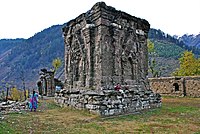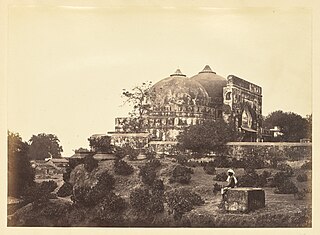
Babri Masjid was a mosque in Ayodhya, India. It has been claimed to have been built upon the site of Ram Janmabhoomi, the legendary birthplace of Rama, a principal deity of Hinduism. It has been a focus of dispute between the Hindu and Muslim communities since the 19th century. According to the mosque's inscriptions, it was built in 1528–29 by Mir Baqi, a commander of the Mughal emperor Babur. Before the 1940s, the masjid was officially known as "Masjid-i-Janmasthan". The mosque was attacked and demolished by a Hindu nationalist mob in 1992, which ignited communal violence across the Indian subcontinent.
The Liberhan Commission was a long-running inquiry commissioned by the Government of India to investigate the destruction of the disputed structure Babri Masjid in Ayodhya in 1992. Led by retired High Court Judge M. S. Liberhan, it was formed on 16 December 1992 by an order of the Indian Home Union Ministry after the demolition of the Babri Masjid in Ayodhya on 6 December and the subsequent riots there. The commission was originally mandated to submit its report within three months. Extensions were given 48 times, and after a delay of 17 years, the one-man commission submitted the report to Prime Minister Manmohan Singh on 30 June 2009. In November 2009, a day after a newspaper published the allegedly leaked contents of the report, the report was tabled in Parliament by the Home Minister P. Chidambaram.
Pakistan has five major ethno-regional communities in Pakistan: Baloch, Muhajir, Punjabis, Pushtuns and Sindhis, as well as several smaller groups. There are also religious and sectarian groups such as Ahmadis, Christians, Hindus, Kalasha, Parsis and Sikhs, and Shia Muslim sects including Ismailis and Bohras.
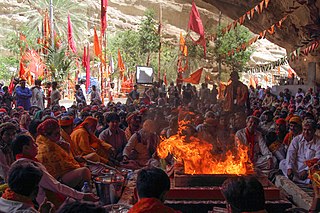
Hinduism is the second largest religious affiliation in Pakistan after Islam. Though Hinduism was one of the dominant faiths in the region a few centuries ago, Hindus accounted for just 2.17% of Pakistan's population in the 2023 Pakistani census. The Umerkot district has the highest percentage of Hindu residents in the country at 54.6%, while Tharparkar district has the most Hindus in absolute numbers at 811,507.

The Shri Katas Raj Temples, also known as Qila Katas, is a complex of several Hindu temples connected to one another by walkways. The temple complex surrounds a pond named Katas which is regarded as sacred by Hindus. The complex is located in the Potohar Plateau region of Pakistan's Punjab province. The temples are located in municipal committee Choa Saidanshah, and are near the M2 Motorway.

The Ayodhya dispute is a political, historical, and socio-religious debate in India, centred on a plot of land in the city of Ayodhya, Uttar Pradesh. The issues revolve around the control of a site regarded since at least the 18th century among many Hindus to be the birthplace of their deity Rama, the history and location of the Babri Masjid mosque at the site, and whether a previous Hindu temple was demolished or modified to create the mosque.

The Shri Swami Narayan Mandir, Karachi is a Hindu temple that is the only Swami Narayan temple in Pakistan. The temple is notable for its size and frontage, over 32,306 square yards (27,012 m2) on the M. A. Jinnah Road in Karachi city. The temple celebrated its anniversary of 216 years in April 2004. There is a sacred cowshed within the premises of this temple. The temple is located at the centre of a Hindu neighbourhood in Karachi. The building that housed a dharmshala for visiting devotees has now been converted to the office of the City District Government.

The demolition of the Babri Masjid was carried out on 6 December 1992 by a large group of activists of the Vishva Hindu Parishad and allied organisations. The 16th-century Babri Masjid in the city of Ayodhya, in Uttar Pradesh, India, had been the subject of a lengthy socio-political dispute, and was targeted after a political rally organised by Hindu nationalist organisations turned violent.
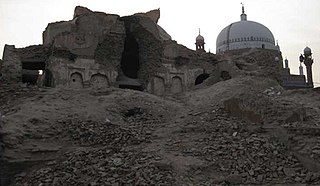
Prahladpuri Temple is a Hindu temple located in Multan city of Punjab province in Pakistan, adjacent to the Shrine of Bahauddin Zakariya. Named after Prahlada, it is dedicated to the Hindu deity Narasimha. In 1992, following the Demolition of the Babri Masjid in India, the temple was razed to ruin in a retaliatory act of violence by a Muslim mob. The site is currently owned by Evacuee Trust Property Board.

Shri Laxmi Narayan Mandir is a Hindu temple located in Karachi, Pakistan. According to the Pakistan Hindu Council, the temple was constructed around 200 years ago and is an important worshiping site for the Hindus of the local community. The Mandir is one of the oldest operating temples and the only one situated at the banks of a creek in Karachi.

The Ram Rath Yatra was a political and religious rally that lasted from September to October 1990. It was organised by the Bharatiya Janata Party (BJP) and its Hindu nationalist affiliates, and led by the then-president of the BJP, L. K. Advani. The purpose of the yatra was to support the agitation, led by the Vishwa Hindu Parishad (VHP) and its affiliates in the Sangh Parivar, to erect a temple to the Hindu deity Rama on the site of the Babri Masjid.
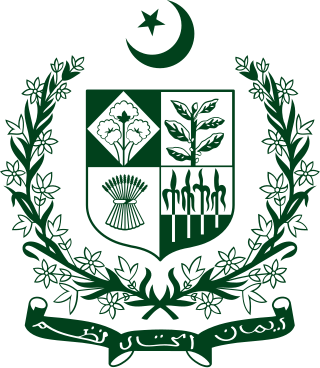
The Evacuee Trust Property Board, a statutory board of the Government of Pakistan, is a key government department which administers evacuee properties, including educational, charitable or religious trusts left behind by Hindus and Sikhs who migrated to India after partition. It also maintains places of worship belonging to Hindus and Sikhs in Pakistan.
Valmiki Temple is a Hindu temple dedicated to Valmiki in Lahore, Pakistan. The temple is managed and maintained by the Pakistan Hindu Council and Evacuee Trust Property Board. In the contemporary era, the Krishna Temple and the Valmiki Temple are the only two functional Hindu temples in Lahore.
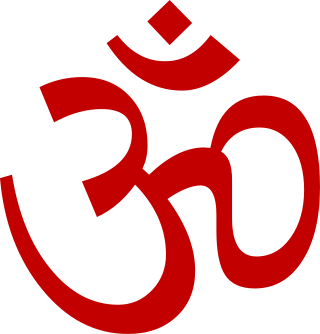
Kalibari Mandir is a Hindu temple in Peshawar, in the Khyber Pakhtunkhwa province of Pakistan. This temple is dedicated to the Hindu goddess Kali and Durga Puja is its main festival.

Goraknath Temple is a Hindu temple located in the Gorkhatri area of Peshawar in Khyber Pakhtunkhwa, Pakistan. The temple is dedicated to Guru Gorakhnath who founded the kanphata Jogi order at Tilla Jogian in the first century BC. The temple was built in 1851.

Lava Temple is a Hindu place of worship dedicated to the Hindu deity Lava, the son of Rama. It is in Lahore Fort, Lahore, Pakistan, and dates to the Sikh period. According to a Hindu legend, Lahore is named after him.
Shri Krishna Mandir, still under construction, is the first Hindu temple to be granted permission to be built in Islamabad, capital of Pakistan, on 0.5 acre land in the H-9 area of Islamabad Capital Territory. It will be a place of worship for the 3,000 Hindu families living in Islamabad. The temple will be managed by the Pakistan Hindu Panchayat. The construction of the temple is controversial: since the approval the construction was challenged by many Islamic extremists and the construction site has been attacked and vandalised four times.
The Pakistan Hindu Mandir Management Committee is the first of its kind instituted by the Ministry of Religious Affairs and Inter-faith Harmony in Pakistan. The committee was formed to oversee the affairs of Hindu places of worship in the country.














